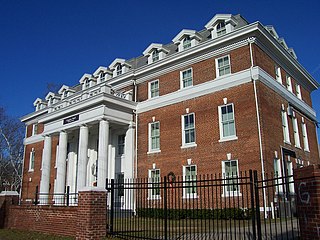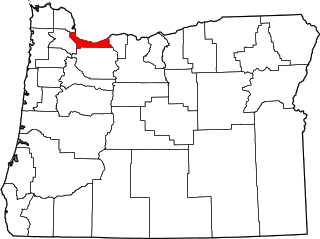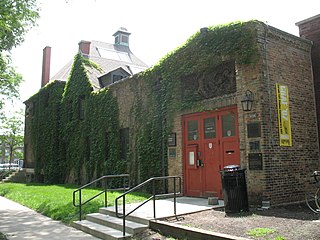
Illinois Institute of Technology (IIT), commonly referred to as Illinois Tech, is a private research university in Chicago, Illinois. Tracing its history to 1890, the present name was adopted upon the merger of the Armour Institute and Lewis Institute in 1940. The university has programs in architecture, business, communications, design, engineering, industrial technology, information technology, law, psychology, and science. It is classified among "R2: Doctoral Universities – High research activity". The university's faculty and alumni include 3 Nobel Prize laureates, 2 Fulbright Scholarship recipients, and 1 recipient of the National Medal of Technology.

The Magnificent Mile, sometimes referred to as The Mag Mile, is an upscale section of Chicago's Michigan Avenue, running from the Chicago River to Oak Street in the Near North Side. The district is located within downtown and one block east of Rush Street. The Magnificent Mile serves as the main thoroughfare between Chicago's Loop business district and its Gold Coast. It is generally the western boundary of the Streeterville neighborhood, to its east, and of River North to the west.

Columbia College Chicago is a private art college in Chicago, Illinois, United States. Founded in 1890, it has 6,493 students pursuing degrees in more than 60 undergraduate and graduate degree programs. It is accredited by the Higher Learning Commission.

Allen University is a private historically black university in Columbia, South Carolina. It has more than 600 students and still serves a predominantly Black constituency. The campus is listed on the National Register of Historic Places as Allen University Historic District.

Philosophy Hall is a building on the campus of Columbia University in New York City. It houses the English, Philosophy, and French departments, along with the university's writing center, part of its registrar's office, and the student lounge of its Graduate School of Arts and Sciences. It is one of the original buildings designed for the university's Morningside Heights campus by McKim, Mead, and White, built in the Italian Renaissance Revival style and completed in 1910. Philosophy Hall is listed on the National Register of Historic Places and has been designated a National Historic Landmark as the site of the invention of FM radio by Edwin Armstrong in the early 1930s.

The following list presents the full set of National Register of Historic Places listings in Multnomah County, Oregon. However, please see separate articles for listings in each of Portland's six quadrants.

The Marquette Building, completed in 1895, is a Chicago landmark that was built by the George A. Fuller Company and designed by architects Holabird & Roche. The building is currently owned by the John D. and Catherine T. MacArthur Foundation. It is located in the community area known as the "Loop" in Cook County, Illinois, United States.

The Black Metropolis–Bronzeville District is a historic African American district in the Bronzeville neighborhood of the Douglas community area on the South Side of Chicago, Illinois.

The Lorado Taft Midway Studios are a historic artist studio complex at South Ingleside Avenue and East 60th Street, on the campus of the University of Chicago on the South Side of Chicago. The architecturally haphazard structure, originating as two converted barns and a Victorian house, was used from 1906 to 1929 as the studio of Lorado Taft (1860-1936), one of the most influential sculptors of the period. A National Historic Landmark, it now houses the university's visual arts department.

The Livestock Exchange Building in Omaha, Nebraska, was built in 1926 at 4920 South 30 Street in South Omaha. It was designed as the centerpiece of the Union Stockyards by architect George Prinz and built by Peter Kiewit and Sons in the Romanesque revival and Northern Italian Renaissance Revival styles. In 1999 it was designated an Omaha Landmark and listed on the National Register of Historic Places. The Union Stockyards were closed in 1999, and the Livestock Exchange Building underwent an extensive renovation over the next several years.

The Robert A. Millikan House is a historic house at 5605 South Woodlawn Avenue in the Hyde Park community area of Chicago, Illinois, Built about 1907, it was from about 1908 until 1921 the home of American physicist Robert A. Millikan (1868-1953), the period in which he made his most significant Nobel Prize winning work. The three-story brick building earned National Historic Landmark status on May 11, 1976.

Immaculata High School was an all-girls Catholic high school located in the Lakeview neighborhood of Chicago, Illinois. It was open from 1921 to 1981.

The West Jackson Boulevard District in Chicago, Illinois, also known as West Jackson Historic District, was listed on the National Register of Historic Places in 1978. It was earlier designed as a Chicago Landmark, in 1976, and expanded as Jackson Boulevard District and Extension in 1997. The NRHP district was expanded in 1989 to include one more building, the James H. Pearson House.

The Chapin and Gore Building is a historic building located at 63 East Adams Street in downtown Chicago, Illinois. The distilling company of Chapin and Gore had the building constructed in 1904 for their business; the original building consisted a first-floor bar and store and offices and warehouse space in the remainder of the building. Architectural partners Richard E. Schmidt and Hugh M. G. Garden designed the building, which has a functional plan but includes substantial ornamentation such as terra cotta and brickwork. The building's ornamental capitals and cornice were removed in the 1950s. The building was listed on the National Register of Historic Places on June 27, 1979, and later designated as a Chicago Landmark on January 21, 1982.

The Chappelle Administration Building, on the campus of Allen University in Columbia, South Carolina, was designed by John Anderson Lankford, known as the "dean of black architects." The building name has been spelled Chapelle Administration Building in HABS and NPS reports. It was declared a National Historic Landmark in 1976, cited as one Lankford's most important works.

The Joseph Henry House is a historic building located on the campus of Princeton University in Princeton, Mercer County, New Jersey, United States. Joseph Henry, a prominent American physicist who worked in electromagnetics, designed the house in 1836 and lived there from its completion in 1838 until taking a position as the first secretary of the Smithsonian Institution in 1848. The construction of the house was offered to the young physicist as part of the University's attempt to hire him away from the Albany Academy in an attempt to raise Princeton's profile. After Henry's departure, the house served as the official housing of the Dean of the College, the University's senior undergraduate academic officer, from 1909 to 1961.

Printers Row, also known as Printing House Row, is a neighborhood located in the south of the Chicago downtown area known as the Loop. The heart of Printers Row is generally defined by Ida B. Wells Drive on the north, Polk Street on the south, Plymouth Court on the east, and the Chicago River on the west. This neighborhood overlaps significantly with the officially designated landmark Printing House Row District to the north of Ida B Wells Drive and the South Loop Printing House District to the south of the Drive. The neighborhood includes Dearborn Station, which is also on the National Register of Historic Places.

Union Park Congregational Church and Carpenter Chapel is a historic church building at 60 N. Ashland Blvd. on the Near West Side of Chicago, Illinois. The chapel is named after Philo Carpenter, a deacon, a co-founder of the congregation and of the Chicago Theological Seminary, and an early donor of the original church who was also a noted abolitionist and the city's first druggist. The two buildings are considered as a unit; together, they are a Chicago Landmark and an Illinois Historic Landmark and are listed on the National Register of Historic Places. The church building is currently occupied by the First Baptist Congregational Church, whose official mailing address is 1613 W. Washington Blvd. in Chicago.



















